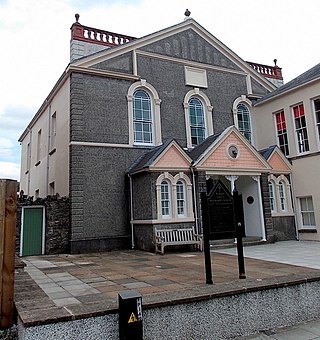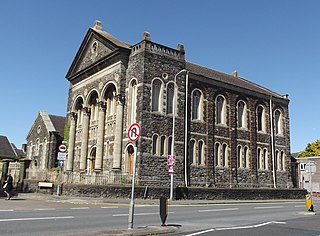
Swansea is a coastal city and the second-largest city of Wales. It forms a principal area, officially known as the City and County of Swansea.

Llanelli is a market town and the largest community in Carmarthenshire and the preserved county of Dyfed, Wales. It is located on the Loughor estuary 10.5 miles (16.9 km) north-west of Swansea and 12 miles (19 km) south-east of the county town, Carmarthen. The town had a population of 25,168 in 2011, estimated in 2019 at 26,225. The local authority was Llanelli Borough Council when the county of Dyfed existed, but it has been under Carmarthenshire County Council since 1996.

Carmarthen is the county town of Carmarthenshire and a community in Wales, lying on the River Towy 8 miles (13 km) north of its estuary in Carmarthen Bay. The population was 14,185 in 2011, down from 15,854 in 2001, but gauged at 16,285 in 2019. It has a claim to be the oldest town in Wales – Old Carmarthen and New Carmarthen became one borough in 1546. It was the most populous borough in Wales in the 16th–18th centuries, described by William Camden as "chief citie of the country". Growth stagnated by the mid-19th century as new settlements developed in the South Wales Coalfield.

Swansea East is a borough constituency represented in the House of Commons of the Parliament of the United Kingdom by Carolyn Harris of the Labour Party.

Landore is the name of an electoral ward in the City and County of Swansea, Wales, UK.
Plasmarl, or Plas-Marl, is a suburban district and historically a village of the City and County of Swansea, Wales. It falls within the old Copper Quarter of Landore electoral ward.
Morfa is a district of Swansea, Wales. It straddles the Bon-y-maen and Landore wards and generally covers the eastern part of the district of Landore.

Landore is a district and community in Swansea, Wales. The district falls in the Landore council ward. A mainly residential area, it is located about 2.5 miles north of Swansea city centre. The north-easterly part of Landore is known as Morfa. There have been a number of new developments in the 21st century, such as the Liberty Stadium, now the Swansea.com Stadium, and the Morfa Shopping Park, which opened in 2005. It had a population of 6,168 as of the 2011 UK census.

In the United Kingdom, the term listed building refers to a building or other structure officially designated as being of special architectural, historical, or cultural significance; Grade II* structures are those considered to be "particularly important buildings of more than special interest". Listing was begun by a provision in the Town and Country Planning Act 1947. Once listed, strict limitations are imposed on the modifications allowed to a building's structure or fittings. In Wales, the authority for listing under the Planning Act 1990 rests with Cadw.

The remains of the Hafod-Morfa Copperworks, originally developed by Vivian & Sons, consists of a core Grade II listed building and additional Grade II listed structures on a 12 acres (4.9 ha) site, on the banks of the River Tawe in Hafod, Swansea.

Plough Lane Chapel or Plough United Reformed Church is a historic building in Brecon, Wales. The chapel's foundation dates to the 17th century and the structure was rebuilt in 1841, then again in 1892. Cadw, the historic environment service of the Welsh Government, listed the chapel as a Grade II* historic building in 1976 for its "unusual porch" and "elaborate and fine interior".

Thomas Thomas was a Welsh church minister and chapel architect, also known as Thomas Glandŵr. He is described as "the first national architect of Wales" and the "unchallenged master of chapel architecture in Wales in the 1860s".

Capel Heol Awst is an Independent Welsh chapel in the town of Carmarthen, Carmarthenshire, Wales. The present building dates from 1826 to 1827, replacing a 1726 building which itself had been enlarged in 1802 and again in 1826 to seat a congregation of 1000. It is located at 7 Friars Park, Carmarthen. It was designated as a Grade II* listed building on 19 May 1981.

Capel Heol Dŵr was a Calvinistic Methodist chapel in the town of Carmarthen, Carmarthenshire, Wales. The building dates from 1831 and is located at Water St, Carmarthen. It was designated as a Grade II listed building on 19 May 1981.

The English Congregational Church, Carmarthen is a Congregational church in the town of Carmarthen, Carmarthenshire, Wales. The building dates from 1861 and is located at 105, Lammas St, Carmarthen. The church was designated as a Grade II listed building on 19 May 1981.

Tabernacle Chapel is an Independent (Congregational) chapel in the town of Llanelli, Carmarthenshire, Wales. It was built in 1872 and is located at 17 Cowell Street. It is a Grade II* listed building.

Capel Als is an Independent (Congregational) chapel in Llanelli, Carmarthenshire, Wales, It is regarded as one of the most significant religious buildings in Wales. Folk tradition suggested that the name refers to a woman named Als, which along with Alys is the Welsh equivalent of the English name Alice, whose cottage stood where the chapel was built. Another theory contends that the Welsh word als translates as rock, and there is a rock-face behind the chapel. However, there is no word "als" in Welsh meaning rock, and so this latter explanation may be safely disregarded.

Thomas Jones was a Welsh Independent minister, known as "the Welsh Poet-Preacher". As a popular preacher he has been compared with William Williams of Wern (1781–1840). His reputation was made, however, by his sermons in English at Bedford Chapel in north London, in a less popular style.

Gellionnen Chapel is a Unitarian place of worship near Pontardawe, South Wales, United Kingdom. The chapel was first built in 1692 by Protestant dissenters, becoming Unitarian in the late 18th century. It is a member of the General Assembly of Unitarian and Free Christian Churches, the umbrella body for British Unitarians. Gellionnen Chapel is the oldest Dissenting chapel in the Swansea Valley, is one of the oldest surviving chapels in the region and is a Grade II* listed building.

The Weybridge United Reformed Church situate at Queen's Road, Weybridge, near to its junction with York Road, is a Victorian Grade II Listed church building that is now no longer used as a place of worship.


















